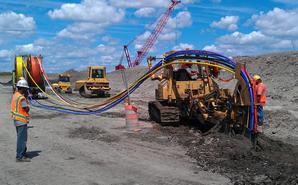By Catherine Kavanaugh
STAFF REPORTER
Published: September 6, 2013 1:41 pm ET
Updated: September 6, 2013 1:44 pm ET

Image By: Plastics Pipe Institute
HDPE conduit
The American Association of State Highway and Transportation Officials (AASHTO) is helping governments and businesses get more miles out of the protective properties of plastic for electrical and fiber optic cable systems.
The non-profit group published a new standard about using high density polyethylene conduit to shield the power and telecommunication cables being buried along the sides of U.S. highways.
AASHTO engineers worked with the Plastics Pipe Institute, Inc. (PPI) to come up with the specifications and requirements for HDPE conduit to protect the nation's power grid and information highway.
The document, which covers material, workmanship and performance requirements, will be a guide for power applications, such as highway and airport lighting, electrical distribution and transmission lines. Communication applications include Intelligent Highway Systems, closed-circuit TV, and fiber optic cables that run along rights of way.
Other applications include pipeline control, positive train control technology, and traffic control and monitoring.
The standard addresses typical installation methods, such as trenching, plowing and horizontal directional drilling.
"This document was the first step in adapting requirements for HDPE conduit that were originally based on the properties of PVC conduit," PPI Executive Director Tony Radoszewski said in a statement.
In addition to being a well-suited as a protective pathway for telecommunication and power cables, HDPE's inherent properties make it ideal for infrastructure and installation. It is resistant to chemicals and stress cracks. It is flexible, strong and can be coiled. And, it can be buried with minimal impact on traffic and the surrounding area.
Also, HDPE conduit is available in larger diameters above six inches for installations requiring multiple inner ducts to run through one service pathway.
The document about its use is formally called "Standard Practice for Solid Wall High-Density Polyethylene Conduit for Non-Pressure Applications Used for the Protection of Power and Telecommunications Cables," or "Standard Practice R 63," for short.
This new document makes it possible to standardize material specifications and insure compliance with other rules governing electrical and fiber optic cable systems, according to Radoszewski,
"This project exemplifies the collaborative nature of the PPI to benefit the industry, communities and citizens by making available proven and effective products which have been vetted by well-respected organizations such as AASHTO," he said in a statement.
PPI is the major trade association representing all segments of the plastic pipe industry. In addition to Radoszewski , participating members from the group included Jennifer Marin of Endot Industries, Inc.; Sarah Patterson, who was with Dow Chemical and is now PPI's technical director; Tom Stewart of the Dura-Line Corporation; and George Zagorsk of, Blue Diamond Industries. Industry consultant Jim Goddard and Bill Bailey of the Virginia Department of Transportation worked on the document as well. Bailey also is chairman of AASHTO's technical section on flexible pipe.
The standard can be found at the AASHTO website: http://transportation.org.
| 